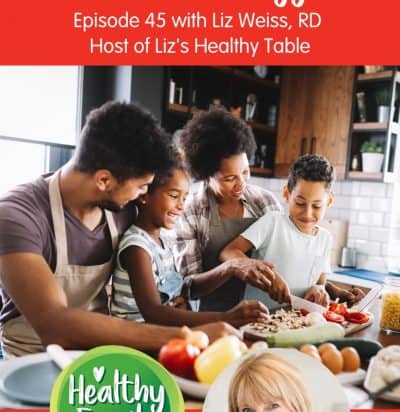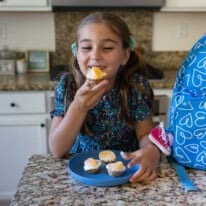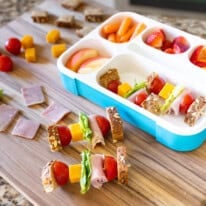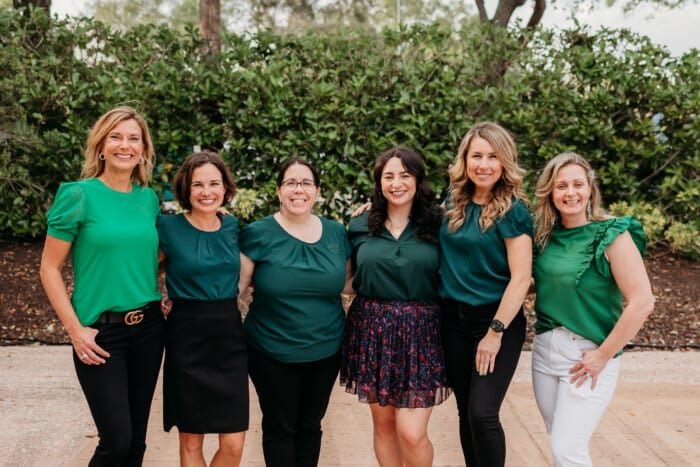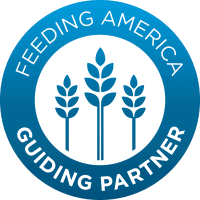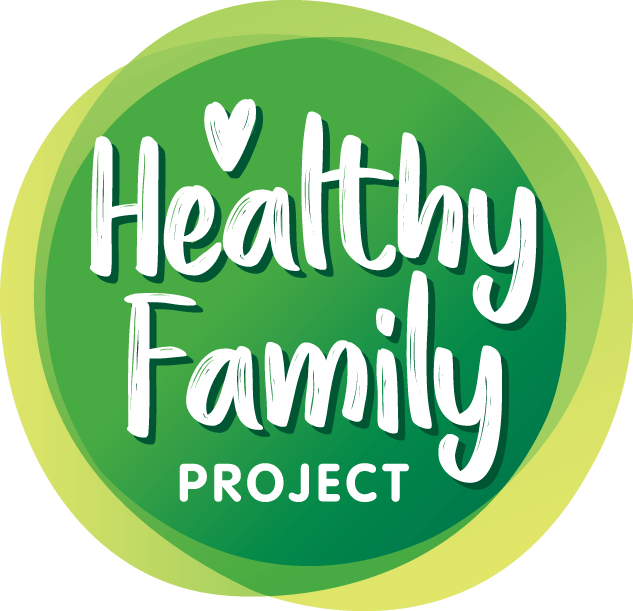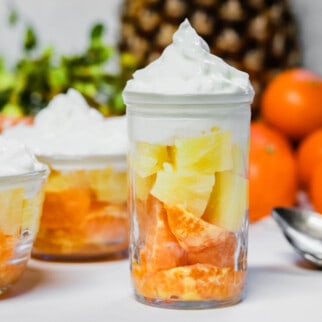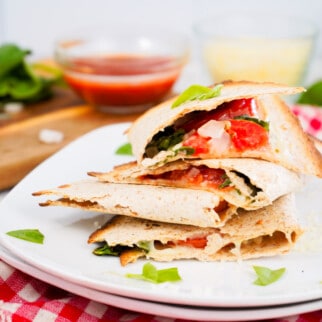Episode 45: Conquering Family Mealtime Struggles
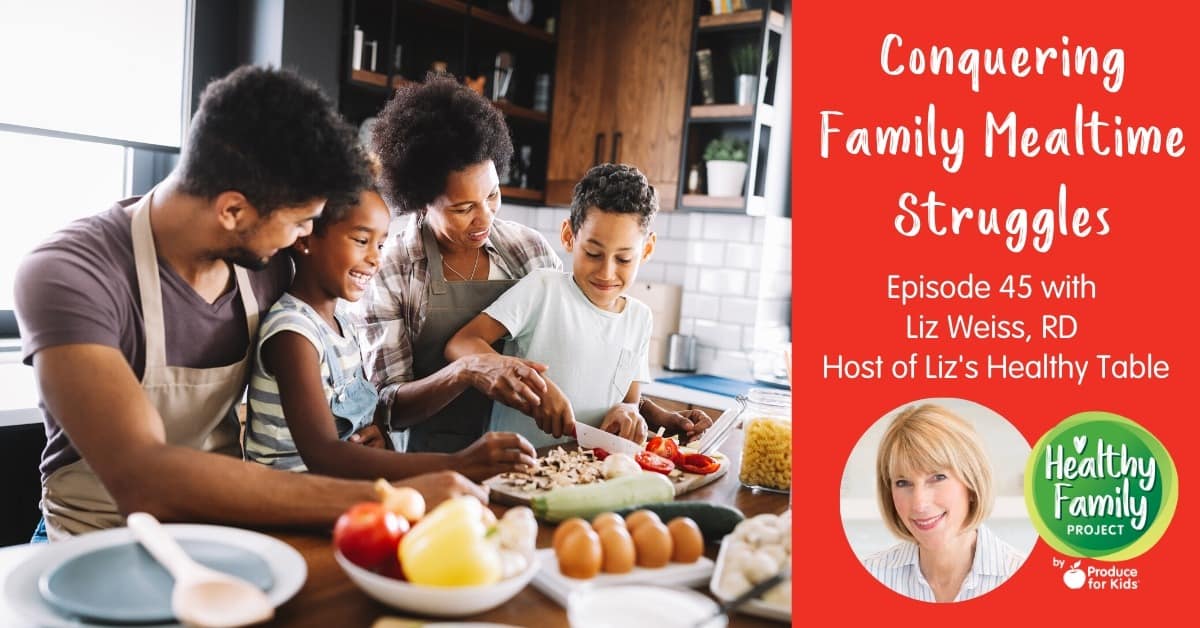
In this episode of the Healthy Family Project, we talk to Liz Weiss, cookbook author, blogger, dietitian, and host of the Liz’s Healthy Table podcast. Liz shares solutions for common mealtime struggles including strategies for picky eaters, meal planning hacks, food waste tips, and more.
Liz has two grown boys, teaches cooking classes to kids, and has a lot of experience helping parents get healthy and happy meals onto the family table.
As an registered dietitian, Liz has been passionate about healthy food and family nutrition for over 20 years and has made helping families discover the joy of wholesome and delicious food her mission.
Her podcast covers everything from fermented foods and why your family should eat them to the benefits of eating more beans. With new episodes published every two weeks featuring expert guests, Liz’s podcast is a great resource for families looking to eat healthier.
Healthy Bite Featuring Autumn Glory Apples
Today, we’re snacking on Autumn Glory apples! This unique apple variety has a very sweet, firm flesh with hints of cinnamon and subtle notes of caramel.
Our junior chefs, Charli and Mia, recently tested six delicious quesadilla combinations made with Autumn Glory apples. They’re so easy to make and perfect for an after-school snack or fun family dinner.
Listener Survey!
Thank you so much for supporting the Healthy Family Project Podcast! We’d love it if you could take 5 minutes to let us know how we can bring you the best possible content for future episodes. Take the survey here.
Healthy Recipes & Tips in Your Inbox
Sign up for the Healthy Family Project e-newsletter to receive healthy recipe inspiration, our latest blog posts and more directly to your inbox each week.
Healthy Family Project Facebook Group
Join our Healthy Family Project Facebook group! This group will serve as a safe space for parents and caregivers to talk all about raising a healthy family – from dealing with a picky eater and tips to get more fruits and veggies onto plates to exercising as a family and mental health. We welcome all of you to join in!
Want to skip straight to a hot topic? See time stamps below. But of course, we recommend listening all the way through!
- 2:11 Welcome, Liz!
- 5:20 How to Make Time for Family Dinner
- 10:50 Strategies for Getting Picky Eaters to Try New Foods
- 15:32 How to Involve Your Kids in Meal Planning & Prep
- 20:13 Healthy Bite Featuring Autumn Glory Apples
- 24:06 Reducing Food Waste & Being More Green in the Kitchen
- 37:31 What does a healthy family mean to you?
Relevant Links
- Check out Liz’s monthly series to help you Reduce Your Kitchen Carbon Footprint
- Listen to Liz’s Healthy Table
- Follow Liz on Instagram, Twitter, and Facebook
- 12 Essential Meal Prep Tools For Every Kitchen
- 7 Tips to Reduce Food Waste & Save Money
- 10 Beginner’s Tips to Meal Planning Like a Pro
- Color, Cook, Eat! – Downloadable Coloring Cookbook Series
- Instant Pot Beef Bourguignon
- How to Grill Cabbage
- Society of St. Andrew Gleaning Network
Other Podcast Episodes to Check Out:
- Episode 23: Make-Ahead Meal Ideas
- Episode 22: Meal Planning for Busy Families
- Episode 21: Meal Planning & Cooking with Kids
- Episode 18: How Families Can Reduce Food Waste
Healthy Family Project Podcast
Conversations covering hot topics in the world of health, food and family with a dose of fun. Helping families ease their way into a new fresh and healthy world.
Be on the lookout for new bi-weekly episodes and don’t forget to subscribe on Apple Podcasts, Google Podcasts, Spotify or your favorite podcasting site. If you like an episode, make sure to leave a rating and comment.
If you are interested in being a guest on the Healthy Family Project podcast, contact amanda@healthyfamilyproject.com with your topic idea for consideration.
Transcript for Episode 45
This transcript was produced by Otter.Ai. Please forgive any misspellings and grammatical errors.
00:13
Welcome to the healthy family project by produce for kids covering the hot topics in the world of health,
food and family with a dose of fun. Today we are talking to Liz Weiss, book author, blogger, dietitian and
host of the Liz’s healthy table podcast. Liz has two grown up boys teaches cooking classes to kids and
has a lot of experience helping parents get healthy and happy meals on to the family table. As a
Registered Dietician Liz has been passionate about healthy eating and healthy food and family nutrition
for over 20 years and has made helping families discover the joy of wholesome and delicious food. Her
mission. Liz’s podcast covers everything from fermented foods and why your family should eat them. I
have not listened to that episode, but I am sure I’ll be a fan and everything else like the health benefits of
eating more beans. Liz posts an episode a new episode every two weeks and invites on expert guests to
join her on the show. I love when the universe knows exactly who to bring into my world next. And I
guess by universe I actually mean our official dietician over here at produce her kids Sally Kazem check,
who was our guest on episode 37. That one was about balancing the holiday Sugar Rush. And then
episode 34 Lunchbox packing mistakes to avoid. So if you’re starting to hit a lunchbox slump, maybe go
back and listen to that one for some inspiration. So Sally introduced me to Liz. And now we are able to
share Liz’s expertise with all of you today. Welcome to the show. Liz, we’re so excited to have you on and
to get some tips from you on how to conquer these, you know, mealtime struggles that we all face and
get over the hurdles. Just a lot of the things that come along with scheduling in that meal time and sitting
down with the family. But before we jump in, can you tell our listeners a little bit about yourself in your
background?
02:11
Sure. Well, thanks for having me. Let’s see. So I’m a dietician. I live in Lexington, Massachusetts, and
looking out my window, a lot of snow on the ground. And I have two boys. So Simon is at the University
of Vermont. And then my older son Josh, lives in New York City works in finance. That’s about all I can
tell you. It’s kind of out of my my realm of specialty. And so I’m going to date myself here. I became a
dietitian in 1982. I have a master’s in nutrition communications, I went to culinary school. So I have a
degree in the culinary arts, and my backgrounds a little bit different because I started actually working as
a journalist at CNN, back in 1987, I was covering food and nutrition for the network. So I combined
journalism and nutrition. It was a really cool job. And I left there and I moved back to Boston and had
various other stints like I worked for PBS for a while, just did a bunch of different things. And you know,
had kids raised the kids wrote a few cookbooks, and I ended up you know, with the whole web, World
Wide Web, kind of the explosion of the web, I launched a brand called meal makeover moms. About
1015 years ago, well that 15 years ago, did meal makeover moms for many years, had a podcast called
Cooking with the moms and then three years ago, I rebranded that to Liz’s healthy table, and that’s kind
of where I’m at now. So I have a blog. And like you, I have a podcast. And my goal is just to help families
eat a healthier diet. So lots of recipes, lots of mealtime tips, you know, I’ve kind of been there done that
with my boys. And I love to share, you know, my experiences with with other parents.
04:03
Well, wonderful. It sounds like you know, with being a dietician and the culinary background, and of
course, Mom, you know, that’s the Yeah, right. You have you have all of that the pioneer of kind of
figuring it all out. So you I’m sure you can, you can help us all here today. So let’s start with the basics,
which I’m going to say just time period, we’re all strapped for time between work and getting the kids to
and from those after school activities, homework projects. I can say myself that this week has been
provided to girls and myself. I don’t I mean, it was a short week, but it was a week let me tell you, I would
you know get up at seven and get everything going and not get back to the house till you know 930 At
night after activities and things like that. So I know a lot of fellow parents They really want to sit down and
have that perfect family dinner around the table. You know, every night like you see in some of the TV
shows, and I know it’s not always an option. So what do you feel like the solution is here? Do we just
make the time somehow I guess? Or do we accept that mealtime can be a little different every day?
05:21
Yeah, you know, it’s a good question. It’s a big challenge for sure. So I guess I would start out by saying
that it’s really important to set goals. And so if you know, if you’re saying to yourself, gee, we really
should eat meals together, more often than I would say, you know, pick the goal of three times a week,
you know, all the research shows that three times a week or more, it’s like the sweet spot. And by that, I
mean, all the benefits of those shared family meals really start to shine through. And so, you know,
benefits include things like eating more fruits and veggies. So kids who eat meals with their families eat
more fruits and vegetables, they eat less junk food, research shows that they have less disordered
eating less substance abuse, this is interesting, better vocabulary, probably because there’s lots of
conversations going on, kind of cool. It also cut it establishes like a lifetime, have fond memories, good
memories, hopefully. And so set those goals, make it a priority. And if you could get, you know, two, three
times a week, that’s awesome. If you could get to four, or even better, just kind of keep building on it. And
then also be flexible. We put so much pressure on ourselves, we think you have to you know, you talked
about that perfect meal you see on TV, the mom, the dad, the two kids, 2.5, kids, whatever, right? It could
be one adult with one kid, it can be you know, any mishmash, you know, it could be a grandparent or a
caregiver with that child, it’s the adult, right, have any adult there to role model to have that conversation.
So be flexible, and kind of the format of that meal. And then also, it can be breakfast, it can be brunch, it
can be a picnic. So don’t put all that pressure on yourself, and instead just kind of go with the flow a little
bit, but make it a priority.
07:07
Right. And I think I think that’s the key is to not not put that pressure on yourself. Because I know this
week, we may think I think we sat down on Monday together. And that has been it. That’s the only day
that we were able to sit down for dinner together. And I’m feeling a little bad about it. But I think it’s okay.
And I think that you hit the nail on the head saying that it doesn’t have to be dinner either. Because you
know, you can do breakfast or brunch or whatever, whatever makes the most sense for your family. I
have to say I just purchased we talked, you talked about vocabulary. I just purchased these napkins, I
forget the brand, I think maybe it’s like Mardi Gras or something like that. But they have, you know, if you
could start like start a new trend tomorrow, what would it be? Or you just want a million dollars or you
have three wishes, you know, and so I have found that because I have a an eighth grader and and
sometimes talking about our day isn’t the the happiest thing maybe
08:17
I understand
08:18
or something, have a lot to say, you know, I felt like oh, these napkins, kind of where I want to talk about
our day. But this is a good way to get everyone in a in a mood where we’re engaging with each other.
And then we can kind of move into, you know, talking about our day, but talking about these fun, you
know, topics that are kind of not around, you know, how was work? How was algebra?
08:46
Oh, that’s an awful conversation. But it’s an it’s like those conversation starters. Right? And you know, I
talk a lot about that you whether it’s a conversation starter on a napkin, or you pick something out of
them, you know, you have little questions, you might fold up and put in a big jar, everybody grabs a
question out, it gets the conversation going around the table. And this is interesting, you know that there
is research to show that when it’s a more positive mealtime experience for everyone, instead of you
didn’t do your homework, you know, I’m mad at you, you know, you know, when you keep it positive. It
research shows that kids end up consuming more fruits and vegetables, you know, they eat healthier,
probably because everybody wants to be at the table and you’re hanging around longer, and it’s not a
struggle. So keeping it it’s not just about coming together around the table. It’s really about keeping it
positive and fun. And I can give you tips on that. But certainly, you know, fun and positive around the
table. And I love the idea of those napkins. I haven’t heard of that. So that’s really cool.
09:42
Yeah, you’ll have to keep an eye out for them. They’re there. Well, they’re really cute and fun, fun topics
to talk about. Even for us parents, you know, I’m like, Huh? What trend would I start?
09:54
What would I do with that million dollar? Right, exactly.
09:57
I have lots of thoughts on that. Yeah. So So time and time again, on this podcast, especially, I talk to
parents, you know, or the guests who are on here I talk about my selective eater. I don’t like the car
picky, my selective eater. And again, I guess we’re here talking a lot about how we’re starved for time.
And so we’re starved for time, we have a picky eater, we want to sit down and have a meal. You know,
and I know, it’s important not to give up and to work with these selective eaters, and not to force things,
but as a parent, it can definitely be a little defeating. So what are some of your tried and true strategies, I
guess, around having that selective eater and still, you know, having a, I guess, quality meal time with
your family without focusing in on on some of those struggles?
10:49
Right, right. Well, let me hopefully, I’ll give you some food for thought here. And you know, some ideas
that are a little bit different. So one thing that I have found to be really successful, not just with myself, but
other people have shared is to serve your meals, family style versus pre plating. And, and the beauty of
that is that kids love control. You know, I you know, with my kids, it was always a struggle, like just to put
their socks on. So I’d say do you want to wear a red sock or a white sock or one of each, you know, they
love that little bit of choice. And so if you serve family style, everybody can have fun serving themselves,
it opens the door for role modeling. So big brother might grab some broccoli and little sister is going to do
the same. And so the pre plating lets everybody pick and choose what they want to eat, takes the battle
out of it. And then you can also control your satiety and you know, your fullness, you could say to
yourself, I’m full, I don’t want more. You know, a lot of times parents are like, push, push, push, you got to
eat more vegetables, or maybe your child just isn’t hungry today. So I love that family style versus the pre
plating. The other thing I love because I’m all about the fun at mealtime is to make meals interactive. And
by that I mean you might sit down and instead of having that traditional meat and potatoes meal, you’re
going to serve a snacking or grazie import. They’re very trendy now on Instagram.
12:08
Yeah, you’re talking my language now.
12:12
I love a grazing board. I actually just summer made us a big snack board. And Simon who’s my 21 year
old he sort of walks in, he’d been working all day start snacking, he literally ate like everything on the
snack board. This is what happens when they grow up, they eat everything. But a snack or grazing board
for dinner is super fun. Or you might have like a build your own burger night or you go and you get like
some, you know, the new veggie burgers that are so popular. They’re either soy based or bean based
and put out all the different toppings and let everybody build their own burger. Maybe you’re not doing
buns, but you’re wrapping them in lettuce leaves, whatever it is. In Oh, you know what else you could
do? You could serve food, I was saying family style that you could serve a restaurant style. So one day a
week, each child has a chance to serve the meal and take your order. And again, it just makes it a little
bit more playful and interactive. And, and just so much fun. And then the other thing I think is really
important. Kids can be selective or picky because an older sibling is and they’re just following along. And
so I used to always say to my kids, don’t Yuck, my yum. You know, if I think that you don’t yuck my Yum,
you could you could take that for me. Or as I would say to Josh, if you dis you’re dismissed, oh, I would
say that’s another good one. Oh, that’s a good one. But that’s the one that is like that’s about setting that
rule. Like if you dis the meal that I have spent all day making, you know, I had to shop and plan and prep,
then you’re going to have to leave the table because if you did something, then Simon’s not going to eat
it because he looks up to you. And so if you decide you’re dismissed, and all you have to do is dismiss
them one time and it will not happen again, I promise. It might feel negative, but I think it’s a rule that you
can establish, enforce and they’re going to get it you know, and so be respectful. And that I think will help
and the other thing is to get rid of distractions and distractions can really take away from the focus on
that family meal. And if you do have a selective eater or picky eater, those distractions can create sort of
chaos at the table and chaos at the table is never good for anyone and by distractions. I mean, turn the
TV off, turn off the cell phones, stop the sibling rivalry get everybody calm, you know, and then when it’s
calm, you can sort of focus on trying new foods and, and you know shake things up too. We tend to think
like sweet potatoes, you must eat sweet potatoes this way. Well, maybe your child doesn’t want mashed
sweet potatoes. Maybe they want roasted sweet potatoes or maybe they want a whole roasted sweet
potato with a bunch of toppers that they can add. Just like you would do like us a stuffed baked potato
You can do a stuffed sweet potato. Maybe they like wedges or fries. So change up the way you present
that one vegetable. And before you know it, they might like it a certain way. And then you feel excited,
like, yeah, they’re finally eating sweet potatoes. And you know, kids are like us, they get bored after a
while, you know, your kids might be on a food jag eating tons of a steamed sweet potato, and then they
don’t want it anymore. To try it a different way. They’re not picky. They’re just bored. You know, they’re no
different from us. Right? We get bored, too.
15:29
Right? Exactly. And Sally, who’s our registered dietitian at producer kids, and I know a good friend of
yours over there. She had a great tip. And this kind of leads me into my my next question for you. But
she said, having when you’re meal planning for the week, what you’re going to what you’re going to be
putting on the table, have each of the kids your take a day? I think it was her that said that and have
them look, okay, so on Tuesdays your day, what, what do you want on Tuesday, you know, and maybe if
you have the time you even involve them in the creation of that, you know, what they have selected, but
then they can kind of each own. You know, like, oh, Today’s my day, I get to have what I requested or
what I wanted, you know, for my dinner.
16:17
Yeah, and I totally agree with that. And, you know, family meals are really a ritual. And so you want to
include kids in that ritual. It’s not your ritual, it’s the family ritual. And, and, and so like, Sally says, have
them help with the meal planning, but also have them help with the meal prep, have them help with
clearing the table, you know, there’s many things they could do to take them to the grocery store. So
there’s ways to involve them. And it doesn’t have to be every facet every day, but just get them involved.
So it becomes this habit. And, you know, when it comes to meal planning, I think one of the easiest ways
to kind of wrap your head around it because I was not born with the organizing gene. I tend to fly by the
seat of my pants. It’s how I roll. And I live in a state of controlled chaos. But that’s me, right? However,
some people need to plan. So I think one of the easiest ways to do it is to think of each night of the week
as a different theme. So it might be Meatless Monday, it could be Taco Tuesday. And believe me, there’s
many ways to make a taco many different could be beef and bean filling. It could be a shrimp filling, it
could be veggie, whatever it is, you might have no waste Wednesday, where you just take all the little
bits and bobs and leftovers that are in the fridge and turn that into a meal. It might be pasta Thursday, or
Freebie Friday, where maybe you do dinner in a movie or something super, you know, different out of the
box, but whatever it is, those themes will help you plan those meals, and then do what I do. And I love to
batch cook, you know, so like on my blog. Right now I have an instant pot recipe, it’s a beef bourguignon.
It’s like a fancy version of the beef stew. And it makes a lot and so they have it, but then I will freeze it.
And I always know I can go down to the freezer and grab that beef bourguignon a month later, and I
have this beautiful meal. So always be kind of thinking like that. And then, you know, use different tools,
like I have a seven day meal planner, a free printable on my website, and I have a supermarket shopping
list on my website, aisle by aisle, people can download, these are little tools that kind of just help you,
you know, sit down on a Saturday and plot it out before you hit the supermarket Sunday morning or
whenever you go. But just getting in again, that habit of making a plan hitting up the supermarket getting
the kids involved. And then before you know it, you know mealtime gets a little bit easier. Right and,
18:43
and I as I have talked to people just really even in my neighborhood, you know, different people wherever
I might be. And if I talk about meal planning it, it’s it’s like scary. You’re like, oh, I don’t have the time to do
that. Who has the time to plan out all your meals. And I keep saying, Well, if I did not do it, my week
would be way more stressful. And I enjoy I enjoy meal planning. So maybe I’m not the right person. I like
knowing that. I’m going to have something you know, planned out for every day I’m kind of on track, I’m
not going to be rushed. Because when I’m rushed, we don’t make the best decisions on what we pick up
to eat or whatever we order so I love meal planning and the girls get involved my girls get involved. I
when we get home from the grocery store on Sunday, we’re such creatures of habit. We do groceries on
Sundays, and when we get home I before I even put my produce away if there’s things that can be
chopped. I leave them on the counter and we get to work before as long as we don’t have somewhere to
be your go at that point. Usually it’s a Sunday, late afternoon. We’ll just all stand there the three of us and
and chop what we need to chop and put it in containers. So that’s all ready to go. Because I feel like
once I put it in the fridge Yeah, chances are choco be right the chances of taking it back out and
chopping are much, much smaller. In today’s healthy bite where snacking on Autumn glory apples and
Grace brought slices over for us to enjoy. Yep, I’m
20:19
here I brought slices. I am crazy about the hands of cinnamon and caramel and these apples. They’re so
perfect for sweet and savory pairing so I’m really excited to snack on these alrighty.
20:34
Come spring apple juice. Well, yeah, I can. I can definitely taste the cinnamon caramel definitely setting
this up ballpark
20:41
for sure. Yeah, and they’re sweet, but not too sweet. It’s just like a very nice flavor combination. I love
them. And in case our listeners haven’t caught up on our blog lately, we actually put together some case
of DHEA combos in your kitchen a few weeks back that I wanted to bring up.
20:56
Yes. So we had a really fun afternoon with my daughters, Mia and Charlie. And they both love making
case ideas. So we thought we’d have some fun with our autumn glory apples and come up with a few
different flavor combinations.
21:10
Yes, it was so fun to see them get creative. We ended up with six different combinations all made with
autumn glory apples. And I have to say my personal favorite was the honey goat cheese and Autumn
glory slices. It was delicious. I love goat cheese, everything. So combined with the honey and apple is
really good. And in case you guys didn’t know me, I summed it all up in a blog post and video which we
will link to up to in the show notes. So you guys definitely have to check it out.
21:36
Yes, I definitely was not mad about sampling all of the different cases do combinations. That was fun.
And the girls were in the kitchen, they made it so we got to sample we added a little extra fun. They
there’s these markers that are safe for writing on food. And so the case idea really is the perfect canvas
for that. Yep, Mia
21:58
was able to trace a really cool Harry Potter map. I’m a huge fan. So I was nerding out over that she did
some doodling and it was just really cool. It’s just an extra dose of fun. If you’re packing these in the
lunchbox or looking to get your, you know, kiddos in the kitchen, it gets them excited to try something
new and get a little creative.
22:14
For sure. So be sure like Gray said, we’ll be posting those links in the show notes. And we’ll include a
few different recipes to try the video. And all of the links around our friends at autumn glory apples. And
then be sure to keep an eye out for autumn glory apples in your local grocery store.
22:33
Right? You want to kind of get that a little jumpstart on the week. And I think to like when you go grocery
shopping, do it at a time of day when it’s not going to be busy. Like there’s nothing worse than getting to
the supermarket. And there’s just like a mob scene. It’s just it’s a it’s a barrier. So if you force yourself like
I always when the boys were at home, always Sunday morning, get up, boom, first thing, hit up the
supermarket, and then you’re done. And is quiet. And I love that. So whatever those obstacles are, you
got to kind of take them on and say all right, I’m going when it’s quiet. And you know, in the summer, it’s
easier, right? You can hit a farmers markets. But this time of year, we tend to be in the supermarket
bundled up running through but have your list and be prepared.
23:16
Right in the group. My girls are nine and 13. And they’re a great ages to help out in the grocery store.
And so, and again, we usually on that grocery run, there’s not much we don’t divert from our weekly list
or weekly staples. So they know what those weekly staples are and they’re, you know, I’ll go run and
grab this I’ll go to the deli, you know, they so they handle those things. And then I handle the kind of off
the cuff new recipe ingredients that I need to find that you know, they probably are like, I don’t know what
you know where this hoisin sauce is.
23:53
Right, right. What is bok choy? Right? Yeah, no, I mean, I think you’re so lucky to have your your helpers,
right. You got two personal assistants. Fabulous. Your personal assistants
24:04
love it. I love it. So I’m really excited to check out your monthly blog series on reducing our carbon
footprint in the kitchen. I know this is a hot topic, we’re all trying to be a little more mindful. And on top of
how our decisions are impacting our planet. On a personal level, reducing food waste, you know, saves
us money, which I love. So it’s a win overall. Can you share some of your top tips for being more green
when it comes to our kitchen habits? Sure,
24:31
sure. Well, I will just start out by saying you know, as a dietitian, I’ve always focused my career on
helping people eat a healthier diet. And this helping the planet was never really part of the conversation.
So it’s a hot topic right now. And as dietitians we’re all about nurturing people but also nurturing the
planet the two must be connected. So I want everyone to get into that mindset of how I shop, how I cook,
how I eat. How does that impact the health of my family, but the health of the planet. And so I’ve started
this new monthly series, and it’s called reduce your kitchen carbon footprint, because I want everybody
to be or feel empowered to change their habits in the kitchen in order to make an impact, positive impact
on climate change, you know, reducing our greenhouse gas emissions. And we can all vote safer
politicians who support sound environmental policies, you know, that’s like the big macro stuff we can do
to get involved in our communities. But at home, what can we do? And I believe it all adds up, right? No,
no idea is a bad idea. So for January, my action for January is to compost. Now, I will preface this
Amanda by saying that I I did try to compost many years ago and I had been in the backyard and I was
hardcore into it, right? Every little food scrap I didn’t eat an egg shell coffee grounds. I’d run outside and
chuck it in the compost bin. And it sat there and it sat there and nothing happened and I felt like a total
failure. And eventually my husband was like, alright, this has got to stop like you got mice living out there
enough is enough. So what I’ve done is I found because our community doesn’t offer it like some DPW
this Department of Public Works will provide composting as a service.
26:17
Are you Yes, Lucky ours does and and I felt kind of bad. My parents are composters and they I think
maybe I was traumatized by the smell. So really,
26:31
it was this mess smell see if we shouldn’t smell like an outside?
26:35
Yeah, I don’t know that it was there. I think they were composting at the very beginning of when this
craze started many years ago and it probably was not the right way.
26:46
Okay, so another maybe perhaps composting fail. But I was I was big failure. And I started noticing a few
months ago in my neighborhood, everybody rolling these little green bins to the you know, end of the
driveway every Thursday. I’m like, what, what is this? Well, it turns out, there’s a service, and you could
subscribe to it. And a lot of communities have this now. It is $99 a year I will say but I think it’s really
worth it because I collect all my little scraps in these little bio bags. They look like plastic bags, but they’re
like biodegradable. And if I’m going to be out of town, I just pop them in the freezer doesn’t matter any all
the bits that I’m collecting, put it in the freezer like I’ve been I was traveling last week, I missed the
Thursday pickup. But yesterday was Thursday. And I filled up the bandwidth, everything that from the
freezer, and I put it outside. And so I’m collecting these things as the week goes on, and putting it outside
in this line to Ben and again, it’s lined with one of those little bio bags or bigger bio bag. And then off it
goes. And this company once a year will deliver a big bag of compost to your door that you can then put
into your garden to nourish your soil. So instead of now instead of all those bits of food, go into waste
and ended up in a landfill. And I will say 40% of the food in this country that’s grown is wasted at some
point in the supply chain transport, you know, at the farm or in transit or at the supermarket or in your
home. But all that wasted food from your home kitchen. If it ends up in a landfill, let me tell you what’s
going to happen, you’re going to think oh, it’s going to biodegrade no big deal. But it is a big deal.
Because when that food goes into a landfill, it gets covered up. And when it gets covered up, it’s no
longer exposed to oxygen. So little bacteria come in and start to break down the food. But these are
methane producing bacteria, meaning they produce methane, which is a greenhouse gas, right. So that’s
not a good thing. So what we want to do is we want to compost it instead. So it’s air rated and all the
bacteria start munching on it. But it doesn’t produce methane because it’s oxygenated, right, it’s exposed
to air. And so you end up with this beautiful organic matter that can then go back and nourish your soil so
that you can grow flowers and produce or healthier grasses or whatever it might be. So we don’t want
that food that we’re wasting or those scraps to end up in a landfill. Or even paper towel rolls. You know,
like the the rolls, that’s organic material, anything from the household. So anyway, so that’s, that’s the
January action, um, composting, I would love everybody else to compost, whether they do it themselves
or their community picks it up or they hire a service. Let’s get all that food out of landfills and back into
the soil. That’s one thing. And then I’m going to be talking a lot about food waste through the year. I’m
going to be talking about how to reduce your use of plastics, how to reduce your use of water, like when
my husband’s doing dishes and the waters running. And then he walks away. I’m like what’s happening?
All those little things. It’s wasteful, or reusable bags, you know, when you go to the grocery store really
becoming more mindful. So it’s just cutting back on. All the things you use and everything we use
requires energy right? You When we think about a food that’s sustainable, or a lifestyle that’s
sustainable, we use this term all the time. Right? What it really means is that that food is what’s for things
that food is nutritious. That food is sourced environmentally. So it came from, you know, it got to me
through a good practices. It’s, it’s affordable. And the fourth pillar is that it’s good for society. And so that
means the farmers were treated well, the workers were treated well, yeah, that farm is really part of my
community. So the four things nutrition, affordability, the environment, and then society. So we have to
start thinking a little differently about our food, and we can all make a big impact. You know, I think all of
us collectively, somebody once said, Oh, this whole thing with plastic straws, nobody, you know, all the
restaurants, nobody has plastic straws anymore, it’s not gonna make a difference. And like, actually, if
you give up plastic straws, it might not make a difference. But if a billion people give up plastic straws,
right, and make a difference, so I think we have power numbers, you know, as parents, grandparents,
you know, we have power in numbers by simply changing our habits in the kitchen.
31:08
And I, I do think that, you know, like, what you’re saying, Oh, I just make this change. What’s that gonna
do? You know, but I do, like you said, if everybody even if it’s just something small to start, you know, it
all makes an impact, no matter how small your effort might seem, I think in the long run, you know, and
you said about the water, my, my teenager, she like she, you know, it’s like, UK, you need to take a
shower. Okay, when she’s in the shower, it’s like, I can’t get you out of the shower. So, this morning, she
was she needed to study and she said, I’m gonna hop in the shower for 10 minutes. And I said, okay, but
you need to set a timer, it has to be 10 minutes. And then she said, I know, I know, your water bill. And I
thought I said, that is a good point. It I do appreciate you thinking about my water bill. But also think
about the water, you know that it’s going down the drain as you stand in there for however long you
choose to be in there. So she said, Oh, yeah, I guess. I guess that does make an impact too. So but
yeah,
32:16
oh, you know, one more thing. And this is something I’m going to talk about throughout the year, is this
concept of biodiversity. And you know, if you think about a farm, if we’re only planting one crop all the
time, that’s not good for the soil. It also doesn’t create like a resilient farm. Because what if like, a drought
came through or you know, something happened, where that crop couldn’t survive, you always want to
have a variety of crops, a variety of plants, like in your garden, certain plants actually will kind of pull
more carbon out of the atmosphere than others, right, they breed carbon. So when it comes to fruits and
veggies, because I know that’s, that’s your true love, right? So when it comes to fruits and veggies, we
want to be thinking about eating more of a variety, because that variety is actually good for the planet,
you know, the more variety, the better. We don’t just want apple orchards or we don’t want just feel to
carrots. So the more variety, the better.
33:10
That’s a good point. And we’ll be if you’re listening right now, we’ll be linking up to everything that we’ve
talked about in the show notes, so you can easily go and follow along and find out how to reduce your
carbon footprint this year. Something we did on Monday for Martin Luther King Day, we always try to
participate in a day of service. As since we’re on the topic of food waste, there’s an organization their,
their Society of St. Andrew and their national but we work with their Florida Division, I guess, if you will,
but what they do out they do is go out. And when they have a call from a farmer, who you know, their
crops have been harvested, or they have the ugly, they just have the ugly produce left. They go out
Society of St. Andrew goes out and cleans the fields. So they pull in volunteers to go out and basically
harvest the crops that would otherwise be plowed under. So we were able to go on Monday and harvest
cabbage, there was a group there’s probably about 12 of us from the neighborhood and some of my
colleagues at produce for kids. And we went out and spent probably about two hours cutting and
harvesting cabbage from the field. And I think we did 1000 pounds. And then what they what they do
after you harvest is they then take those crops to the local food banks. So you know we’re talking about it
all this but you know, I’m pretty passionate about the fact that there’s a huge disconnect from these crops
that aren’t suitable for the grocery store because you know, they have a blemish or they’re not they just
don’t you know, the shopper is not going to pay for for that but yet we have so many hungry people so I
know so So that was awesome. And so I’ll link up to that too, because I know they have opportunities for
fam or anyone really to go out and volunteer and help them. That’s really they just need the hands to get
out there and harvest whatever it might be, and then they take care of the rest. So it was really
rewarding. And I my kids actually really enjoyed, you know, I mean, who doesn’t enjoy a couple hours
just out in beautiful weather and fit in the field and right, it was just a beautiful, beautiful day. So we’ll
definitely link up to that, too.
35:33
I love that. And I love that that experience and that story. And, you know, and it makes me think about
cabbage, because, you know, if somebody walks into, say, a food pantry, and they grab this cabbage, the
missing link quite often there is they don’t know what to do with it yet. A lot of people are like, What do I
do with this giant cabbage. And I will say, and I should send you a link, I do have a recipe on my blog for
roasted or grilled cabbage. And I’m addicted to it. And cabbage when you kind of slice it in half and then
kind of cut it into quarters. So it’s not so big and unwieldy. Cut it into wedges, right? And then just drizzle
with olive oil and salt, pepper, maybe some chopped rosemary, and just wrap it up in foil. Just chuck it in
the oven or check out the grill.
36:14
Yeah. Oh, good. Well, definitely, we’ll definitely link up to that recipe because that is one of those. That’s
what is one of those produce items that oftentimes you’re kind of like, do I do in this?
36:25
How much? How much can I put in a salad? This is like the biggest head of cabbage, right in my life?
How am I ever gonna eat this like a bowling ball? How am I gonna eat this whole thing? So you have to
get creative. You know, it’s I love it chopped in a salad to or even sauteed or and I was just in Budapest,
Hungary. And they have a traditional recipe where they cook up egg noodles, and or any kind of pasta
noodles and then they add sauteed cabbage and onion. And it’s so good. It sounds weird, but it’s so
good. It’s a Hungarian dish, and it’s like a delicious combination. Maybe not the most colorful, but really
healthy and delicious.
37:03
That sounds good. Well, I asked all my guests the same question. So before we close out here, which I
You’re definitely gonna have to be back on the podcast because I feel like we could, we could continue
talking for quite some time. But before we close out, I have been asking everybody, what do you think it
means to be a healthy family? There’s no right or wrong answer. It doesn’t have to be food related. I just
enjoy everyone sharing their thoughts on this question.
37:32
Well, since we have been talking about family meals, I will I will tie it into it because I’m so passionate
about family meal time. So for me, I would say that a healthy family as a family that makes a habit out of
gathering around the table and eating together. I just feel like you know, it’s good for the body and the
soul. And it just gives everybody this opportunity to sit down, take a breath from their busy days and
connect and it just creates awesome long lasting memories. You know, you can think back to like the
aroma of your mom’s roasted chicken, right? Maybe a silly word game, like your napkin game, you know,
it just it just lets everybody catch up. And just kind of savor that time together. So I would just say a
healthy family is a family who eats together as much as they can do, you know as much as they can
make possible.
38:22
Wonderful. Well, and then I guess Lastly, where can everyone find you? Because I’m sure after this
episode, everyone’s gonna be looking to connect and learn more and follow along on this journey. So
can you tell us where to find you?
38:35
Oh, yeah, so I My website is Liz’s with an S lysis. Healthy table calm. And that’s where they’ll find my
blog with recipes I’ve got, I never even mentioned this. I have a coloring cookbook series called color,
cook, eat color, cook, eat to download, and it’s coloring pages and recipes. And it’s so playful and so fun.
So for kids who might be like losing it when you’re making dinner, just get them coloring, keep them busy,
make it food related, why not. And then I’ve got my podcast, Liz’s healthy table and I have guests on and
we tackle all sorts of issues, you know, from family meal time to snacking to cooking with less sugar, like
you name it. So you and I are definitely in the in same world. And I think our shows really support one
another. So I’m, I’m excited. You know that we had a chance to chat today. So thank you. So yeah, Liz’s
healthy table. And then once you’re on the website, you can connect through to all my social media cuz
I’m on you know, Instagram and Twitter and the usual character.
39:35
Oh, all of the above. Well, thanks. And we’ll link up so you know, no need to be taking notes. We’ll link up
to everything in the show notes. So you can click through and find Liz. And thank you so much, Liz, I
know you’ve been traveling and so I truly appreciate you making the time to talk to us today. And give us
all of these wonderful tips and hopefully we’ll have you back soon. Got a great conversation today? I
think I’m gonna have to get back on the composting. Oh, let you guys know, I have to update you on how
that how that is going for me. But I do think that it’s something that I can incorporate into my 2020 plan.
But if you don’t currently have family meals in your day to day schedule, don’t feel bad. Just try making
some time for at least once a week and start small. It’s hard. I know our busy schedules here with my
family don’t always allow for a family meal every day, that’s for sure. But we do slide in a few a week.
And it really does make all the difference. If you have a topic you’d like us to cover, you can share it in
the comments or share it in our healthy family Project Facebook group. We are always interested in
feedback from listeners, and then don’t miss out on our seasonal recipes on produce for kids.com. I
know it’s the time of year that everyone’s looking for those slow cooker meals and soups and chilis. We
have you covered and I’ll link up to a few of those in those ideas in the show notes. If you like the healthy
family project, which I hope you do, please tell a friend and leave us a rating it will only help our visibility
so we can continue to create a healthier generation. If you want to tweet direct with me. I’m at Amanda M
Kiefer on Twitter and Instagram and you can find produce for kids on Facebook, Twitter, Instagram,
Pinterest and YouTube. Be sure to subscribe Talk soon

